A Hill Sheep Farmer's Year
Hill sheep farming is a tough and busy life, every day, all day - and some nights! This is a simplified account of one farmer's schedule:-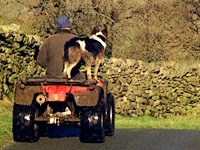 |
 |
 |
November: Tups are put in with the ewes. Each tup is marked with coloured raddle on its chest which will transfer to the ewe it services. Changing the colour at weekly intervals will allow the farmer to know when lambs are due, as well as identifying the tup.
December: Fat lambs continue to be sold off for meat. Sheep are dosed for flukes.
January: Pregnant sheep will need the hay harvested last summer, especially when the land is covered with snow. Up on the fells there are a few small barns (hoghouses) now derelict, which were used for storing winter feed before quad bikes made it easier to deliver hay in all weathers.
 |
 |
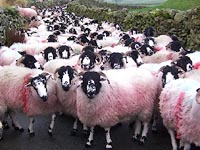 |
February: The pregnant ewes are scanned with ultrasound - outdoors! Colour marked on the ewes indicate if twins or triplets are expected, and these sheep will get increased supplements.
March: Sheep are moved around all through the year to make best use of the land available, getting the best grazing for the sheep whilst maintaining the fields. Most flocks will graze both pasture and fell. Many farms have scattered fields and will use road and tracks to move their sheep.
April: Lambing time, day and night. Some farmers lamb outside, others in barns. Several times a day the farmers drive round their fields mothering the ewes off with their lambs. The shepherds' crook is still an invaluable tool.
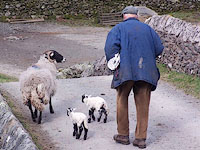 |  |
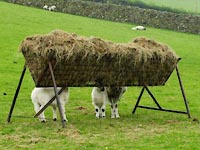 |
May: Lambs go to the fells with the ewes so that the journey and the land becomes familiar to them. Emptying the low fields allows the grass to grow. The sheep will be brought back after haymaking.
June: Time for a very short break? But there is always maintenance to be done, mending walls and fences. And paperwork.
July: Haymaking and clipping. Make hay whilst the sun shines, often well into the night. And when it rains there is the clipping to be done, but who wants to clip wet sheep? Every sheep carries a smit mark, its colour, style and position indicating which flock it belongs to, and it has to be reapplied after clipping. Shepherds Guides containing this information have been published since 1817, and stray sheep used to be returned to their owners once or twice a year at the Shepherds' Meet or Gathering.
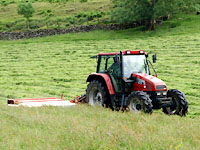 | 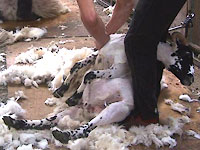 |
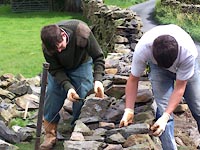 |
August: Lambs are weaned this month. The pure-bred gimmer lambs come off the fells.
September: The time for local and county Shows, focussed on the Shepherds Meet, where sheep are judged and rosettes awarded. Cross-bred female lambs are sold on at auction, to be cross-bred again with less hardy downland sheep.
October: Tup sales, selling and buying from specialist flocks, and replacing stock to avoid inbreeding. Pure bred ewe lambs are sent away to lower pastures for the winter. They will not breed until the following year. Fat lambs (male) are sold for meat.
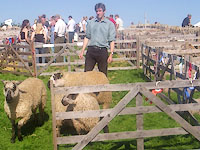 showing Teeswater sheep 2004, Murthwaite flock |
 Shepherds Guide 1817, showing smit mark for 'Thomshow' flock |
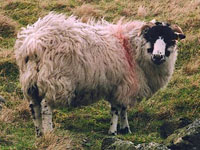 Rough Fell sheep 2007 Toms Howe flock |
Rough Fell sheep are a local breed. There are over 1,000 in Longsleddale, a significant proportion of the total in the country. For more information on Rough Fell Sheep, contact Richard Simpson on 01539 823682
There is a registered flock of Teeswaters in Longsleddale. For more information on Teeswater Sheep, contact David Waine on 01539 823199
Entries for Longsleddale in the Shepherd's Guides can be seen under Local Records on this website.
More general information and pictures about Smit marks, Stone walls, Sheep feeders can be found online under Topics in Guides to the Lakes
 Longsleddale Home Page
Longsleddale Home Page
|